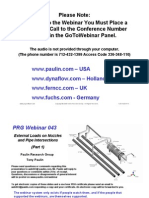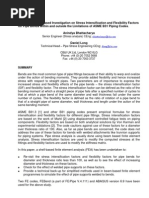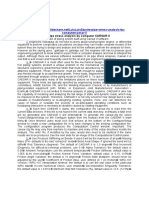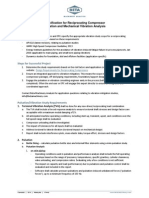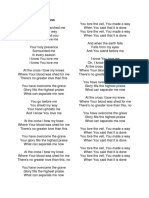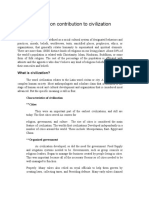AIV
Uploaded by
guslohAIV
Uploaded by
guslohSee
discussions, stats, and author profiles for this publication at: http://www.researchgate.net/publication/260778573
Piping fatigue failures by acoustically induced
vibration: when design optimization may
sacrifice mechanical integrity and safety
CONFERENCE PAPER MARCH 2013
READS
163
3 AUTHORS, INCLUDING:
Rosario Aniello Romano
Raffaele Dragonetti
University of Naples Federico II
University of Naples Federico II
64 PUBLICATIONS 43 CITATIONS
47 PUBLICATIONS 24 CITATIONS
SEE PROFILE
SEE PROFILE
Available from: Rosario Aniello Romano
Retrieved on: 07 October 2015
AIA-DAGA 2013 Merano
Piping fatigue failures by acoustically induced vibration: when design optimization
may sacrifice mechanical integrity and safety
Rosario Romano1, Giuseppe Squadrone2, Raffaele Dragonetti1
1
University of Naples Federico II, 80125 Naples, Italy, Email: rosroman@unina.it
DESIGN HSE Noise Control Group - TECNIMONT S.p.A., 20124 Milan, Italy, Email: g.squadrone@tecnimont.it
Introduction
In industrial plants, process piping subjected to the
vibrations induced by high frequency acoustic excitation of
high pressure letdown devices, associated with large-flow
gas systems, may led to fatigue failures within few minutes
or hours. This mechanism, well known as Acoustically
Induced Vibration (AIV), has been formerly recognized,
documented and analyzed by Carucci-Mueller [1] at early
80s and a safe design limit curve, plotted as theoretical
sound power level inside pipe (Lw) versus pipe diameter, was
proposed. In the late 90s the Marine Technology
Directorate (MTD) encouraged a deep investigation on this
subject and, as outcome, a guideline, then improved by
Energy Institute (EI), was published containing most
accurate risk assessment criterion, based on the mechanical
parameter Likelihood Of Failure [2]. According data
published by UK Health and Safety Executive piping
vibration fatigue accounts, at least, for 20% of hydrocarbon
releases in the North Sea UK Sector [3]. Overall statistics
are not available for the onshore facilities, but individual
plant pipework failure data relevant to the Western Europe,
show that between 10% and 15% of them is due to vibration
induced fatigue. Besides, based on a more recent publication
summarizing the largest property damages in the
hydrocarbon industry [4], it has been deducted that up to
2009, more than 10.7 billion USD losses and over 200
people killed could have been caused by pipe fatigue cracks.
This paper reports on AIV risk assessment performed by
means of either Carucci-Mueller or EI method and based on
the analysis of data provided by TECNIMONT through a
series of activities carried out during the design of industrial
plants in recent years.
the piping system including branch connections, small vent
and drain connections - Small Bore Connections (SBC) -,
pipe supports and guide locations. The effects related to
piping system vibrations are piping fatigue and fretting.
Piping fatigue lead to cracks that will evolve in wall
fractures and pipe ruptures, the most sensitive locations
being welded joints. Fretting is the simple contact between
surfaces in cyclic relative motion, one or both of the surfaces
will be worn away, then the contained fluid will leak outside
the pipeline.
The procedure to limit AIV fatigue in process piping is
mainly organized in two steps: risk assessment and
corrective action on piping system. The AIV risk assessment
methodology is then split in two stages: the screening and
the detailed analysis. In any case, the whole activity shall be
carried out provided that the piping mechanical design have
been already conducted by applying the good engineering
practices and other standardized design rules. The screening
stage is necessary to select which piping systems shall be
subjected to the detailed analysis and which not, due to the
time consuming detailed investigation activity, to avoid
wasting time checking lines not at risk AIV.
The screening is conducted by means of questionnaires or by
checking the value of specific process parameters, either
simple or combined, related to the released vibrational
energy. The information necessary for the screening are very
few and the more are detailed, the more the result will be
accurate and useful for the following steps.
According to EI screening criteria, the following piping
systems are not subjected to AIV risk:
liquid or multiphase flow lines;
gas systems in which is neither chocked flow possible
nor sonic flow velocities likely to be encountered.
Background and Methodology
AIV is a phenomenon generally due to high flow rate and
pressure drop at pressure reducing devices of gas systems,
such as Pressure Safety Valves (PSV), Control Valves (CV)
or depressurizing valves, and results in high sound levels of
high frequency acoustic energy; typical dominant
frequencies are between 500 to 2000 Hz. AIV is usually
characterized at the point of flow restriction by choked flow
and shock wave conditions resulting in an intense area for
turbulent
flow pressure fluctuations
immediately
downstream of the point of flow restriction. This generates
acoustic energy that propagates inside the pipe as an acoustic
wave together with propagating structure borne vibration
energy within pipe wall. The propagating acoustic wave has
high order modes that tend to couple well with the pipe wall
flexural modes exciting circumferential vibrations. AIV
failures occur at geometric asymmetries and stress raisers in
Further to above conditions, Carucci-Mueller screening
method (along with ones given by Eisinger [5] and Norsok
Standard L-002 [6]) includes additional criteria to select
piping systems not subjected to AIV risk:
gas systems discharging directly to the atmosphere
through a short tail pipe;
single pressure let downs where the discharge pipe has
a nominal diameter (DN) 6 or smaller for full length;
piping connected to valves whose estimate of sound
pressure level at 1 m downstream of the valve and 1 m
normal to the pipe are below the value of 110 dBA.
The second level detailed risk assessment analysis is
performed by mean of calculation in which the input data are
related both to the process and to the pipe geometry. For
AIV risk assessment, EI defines detailed analysis procedures
1526
AIA-DAGA 2013 Merano
that generate Likelihood Of Failure (LOF) numbers for each
piping systems and operating scenario under consideration.
EI stress that their LOF numbers represent a conservative
assessment to be used for inspection purposes. LOF is not an
absolute probability of failure nor an absolute measure of
failure. The calculations are based on simplified models to
ensure ease of application and are necessarily conservative
and drawn on EI collated field data and experience. AIV risk
assessment based on Carucci-Mueller method need not to
implicate the LOF numbers, since it has been developed by
means of physical parameters, instead of fatigue life cycles
evaluation. Also for this method it has to be strongly
remarked that the resulting values, to be compared with the
applicable limits, do not represent any consistent fluiddynamic phenomenon actually occurring in the pressure
letdown device, nor measurable quantities.
The main parameter to be calculated for the AIV detailed
risk assessment, either with EI or Carucci-Mueller method,
is the released sound power level downstream the pressure
letdown device with the following equation, which was
developed by Carucci and Mueller using basic control valves
combined with their empirical field data:
3 .6
1.2
P T
L w = 10 log W 2
+ 126.1 + SFF
P1 MW
[dB]
(1)
where Lw is the internal pipe sound power level, W is the
flow rate of the gas (kg/s), P is the total pressure drop
across the valve (bar), P1 is the absolute upstream pressure
(bar), T is the temperature of upstream gas (K), MW is the
molecular weight of flowing gas and SFF is a correction
factor, applicable for EI method only, to account for sonic
flow. If sonic condition exists, then SFF is 6 dB; otherwise
SFF is 0.
It has to be remarked that this Lw does not represent the
actual sound power level inside the pipe, but only the
reference value to be used for AIV risk assessment. There is
no relationship with the predictable control valve sound
pressure level at 1m from the downstream piping. The Lw
value obtained downstream the pressure release valve is
propagated along the pipe at the sections where the
circumferential discontinuities are located, taking into
account corrective factors for distance attenuation, piping
material and connection dimensions and type, where present.
The calculated Lw at piping section has to be checked versus
either internal pipe diameter (Carucci-Mueller) or pipe
diameter and thickness ratio (Norsok Standard). The
remedial actions are then chosen based on the exceeding
level in dB over the design limit curve and include the
reduction of the involved acoustic energy (at source or along
the downstream pipe) or the modification of piping system
response at critical points. Otherwise, by applying the EI
method, a complex calculation has to be performed,
combining piping system length, diameter thicknesses,
branch connection and pipe material types, dynamic stress
versus cycles to failure graph and other details to obtain the
comprehensive LOF number. The AIV risk assessment is
then obtained by comparing LOF number with 1: if
LOF < 1 then remedial actions as above are suggested, if
LOF 1 then remedial action shall be applied. If
LOF < 0.3 no AIV risk exists at all.
Besides of the Lw design limit curve above defined, other
acoustic and vibration consulting companies have worked
out custom limit curves based on their own experiences
[7] or as a function of the ratio between the internal pipe
diameter and the squared pipe wall thickness [8]. The overall
risk assessment method given in the EI guidelines, includes
also specialists vibration measurement techniques with
dynamic strain gauges (useful for operating plants) and
specialist predictive techniques, like Finite Elements
Analysis, but its use is generally very limited, due to the
heavy impact on project time schedules. For sake of
completeness, it has to be mentioned also the AIV risk
assessment methods based on the calculation of dynamic
stress at piping geometrical asymmetries, based on the
evaluation of vibration velocity propagating along the pipe
from the sound power source, but its use is very limited due
to the difficulties in the calculation of actual sound power
level at downstream valve and because this method has not
been yet officially standardised [9, 10].
The application of above methodologies is strongly driven
by project schedule, more and more reduced, so that AIV
assessment and control shall be performed at early stage,
when design data are often not yet consolidated. Main
problems are related to the need to define largest piping size
and wall thicknesses at earliest to allow their procurement in
time. Possible approach is to work with preliminary process
data, disregarding layout information since not reliable at
project beginning, but assuming conservative margins
deriving from previous experiences to ensure thorough and
robust decisions. It has to be remarked that, setting piping
wall thickness along with support and branch reinforcement
requirements early, the design effectiveness is improved,
limiting future intervention on very few situations, giving
then positive impacts on the project schedule.
Tecnimont AIV experiences and results
Although AIV issues are known since last years of past
century, Tecnimont experience in this field begun around
2003, when some project including this requirement in the
contract documentation was awarded. Actually, at that time,
Tecnimont was not involved in piping systems subjected at
AIV risk. Besides, in the Tecnimonts historical core
business, that is polyolefin production plants, this risk is
very limited, due to the relatively low pressure drops,
discharged flow rates and small piping size present in this
plant type. As shown in the above sections AIV risk
assessment and design of corrective actions is a
multidisciplinary activity that shall be performed with the
factual contribution of different skilled subjects each
intervening at right time, to avoid wasting resources and
provide for comprehensive and definitive choices. Therefore
Tecnimont has adopted a procedure to ensure the right
awareness and responsibility, based on the synergic
contribution of different involved specialists, according
below sequence:
1527
AIA-DAGA 2013 Merano
the department in charge for the design of fluiddynamic conditions and valve sizing of the discharge
(Process) selects the valves to be investigated for AIV,
based on the screening criteria (DN > 6 and Lw > 155
dB) with the assistance of noise control specialists
group;
for the valves at AIV risk only, the valve process
conditions and the downstream pipe size are modified,
if possible, to obtain an acceptable residual risk level
to be controlled with piping modifications;
the exceeding residual risk level is controlled by
designing piping modifications on pipe thickness,
routing, full encirclement supports and reinforced
branch connections with the contribution of plant
design specialists.
This procedure is under revision and optimization to reduce
the time necessary for the design and remove critical issue
like, for example, the cyclic process of some activity.
In the Table 1 are summarized the main information
concerning industrial plants designed by Tecnimont in which
the approach reported in the previous section has been
applied to reduce and control AIV risk.
Project
Location
Capacity (typical measurement unit of
petrochemical and oil and gas industries)
Plant type
Reference year
PetroRabigh
Kingdom Saudi
Arabia (KSA)
900 kt/y PE
Polyolefin
Design 2006
Startup 2008
Borouge 2
United Arab
Emirates (UAE)
540 kt/y PE, 800 kt/y PP
Polyolefin
Design 2008
Startup 2010
Gasco
United Arab
Emirates (UAE)
900 mmscfd GT, 5200 tonnes/day sulphur
recovery
Oil & Gas
Design 2010
Startup 2013
South Pars 12
Iran
3 bscfd GT
Oil & Gas
Design 2011
Borouge 3
United Arab
Emirates (UAE)
1080 kt/y PE, 908 kt/y PP, 350 kt/y LDPE
Polyolefin
Design 2011
Acid Gas Removal
Package (AGRP)
Kuwait
230 mmscfd NG, 78k barrels/day
condensated
Oil & Gas
Design 2011
Table 1: Tecnimont experiences in AIV risk assessment and control.
Data about Tecnimont experiences on AIV risk assessment
and control have been are organized as follows:
the considered letdown devices are the Pressure Safety
Valves (PSV), the On/Off Valves (XV) and the Control
Valves (CV) operating as depressurizing system in
emergency case;
PSV are installed to protect equipment or piping
systems by the risks connected to overpressure;
the data are organized in project plant units (e.g.
Petrorabigh - EPPE, Gasco - Fuel Gas System, etc.);
PSV total is the total count of safety valves
discharging Gas in a closed system (e.g. blowdown,
flare, etc.);
PSV Scrn is the count of safety valves that have been
screened to be further analysed, by applying the criteria
of minimum pipe diameter (DN > 6) or minimum
internal sound power level Lw calculated with equation
(1) (Lw > 155 dB)
PSV Risk and PSV Risk and High Risk (for Oil &
Gas units only) is the number of PSV which
downstream piping system have been assessed to be
subjected at acoustic fatigue;
XV Risk, CV Risk, XV Risk and High Risk and
CV Risk and High Risk (for Oil & Gas units only) is
the number of XV and CV which connected piping
have been assessed to be at AIV risk (as XV and CV
are generally used for purposes other than the
emergency depressurization, their total and screened
counts has not been reported).
The results of data analysis are summarized in Figure 1 and
Figure 2 for petrochemical polymer plant type and Oil and
Gas plant type respectively. They allow to make the
following considerations. Polyolefin plants are less
subjected at AIV risk, reasonably due to the limited pressure
drops across letdown devices (about 30 bar), the low
discharged flow rates, the small sizes of both the valve
downstream pipes (no more than DN 18) and the flare
headers (usually DN 36).
Figure 1: AIV risk assessment for petrochemical polymer
plant type.
Besides, no piping systems have been assessed at High AIV
fatigue risk, which means the limit exceeding is not very
high. Piping design changes have not much impact in the
project design and in the material purchasing, if AIV risk
assessment is performed in time.
1528
AIA-DAGA 2013 Merano
of pipe routing and layout occurring during operative plant
engineering stage. In any case it has to be remarked that,
extra costs associated to AIV piping fatigue prevention are,
like all safety costs, related to a design condition valid for
emergency or incidental scenarios only.
Conclusions and future developments
Figure 2: AIV risk assessment for Oil and Gas plant type.
Oil and Gas plants have more piping system at AIV risk; in
them the pressure drops are often high (up to 80 bar and
more), the released flow rates are prominent, the sizes of the
pipes downstream the valve and the flare headers are
significant (respectively DN 24 to DN 36 and up to DN
60). For some piping system the High AIV fatigue risk can
exist, therefore, in general, it is not excluded that the whole
discharging piping should be completely redesigned, in
utmost situations, if encountered. Further, the changes or
improvements in the piping systems and, possibly, in the
valve type will determine significant impact in the project
schedule and procurement, therefore the AIV risk
assessment shall be performed at earliest.
The above information, included the one relevant to plant
units with no piping systems to be deeply investigated for
AIV risk assessment, is very useful for Tecnimont when
estimating the man hours necessary for the project
development. To give an idea of the amount of the design
changes occurring in a industrial plant, in Table 2 is reported
a summary of main corrective actions planned for an
example of Oil and Gas project (Gasco).
Design modification
Actions on
the AIV
source
AIV
corrective
actions on
piping
response
Yes
Low noise Control
Valves
4 valves (DN 36
and DN 42)
Valve Branch
Extension
4 DN 36 lines up
to 80m,
2 DN 36 lines up
to 200 m
Pipe wall
thickness
increasing
45 lines, about 3200
m and 134000 kg
weight increase
Full encirclement
support
58 lines,
corresponding to
456 supports
Branch connection
ring reinforcement
12 branches (10 DN
42 and 2 DN 60)
For this task, however, previous experiences on AIV risk
assessment and control are very useful for reliable design, so
Tecnimont has started a systematic analysis of available
data. Meanwhile Tecnimont is reinforcing its AIV approach
by taking into account the most recent developments and
outcomes on the issue, considering also the application of
international codes especially dedicated to the mechanical
design of structures subjected to high frequency fatigue
stress.
References
[1] Carucci V.A., Mueller R.T.: Acoustically Induced Piping
Vibration in High Capacity Pressure Reducing Systems,
ASME Paper 82-WA/PVP-8 (1982)
[2] Guidelines for the Avoidance of Vibration Induced
Fatigue Failure in process Pipework, Energy Institute,
second edition (2008)
[3] Offshore hydrocarbon release statistics and analysis,
HSR 2002/002, HSE (2003)
Quantity
(if available)
Multiple discharge
parallel lines
Joint mechanical integrity, safety and design optimization of
depressurizing piping systems is a critical issue in
petrochemical and oil and gas industries. Tecnimont has set
up a dedicated task force, in which one of the author is
involved, to define a work instruction dedicated to the proper
address of the AIV risk assessment and control by using
well-established methodologies and procedures. This
approach allows ensuring optimized piping system designs
in terms of global costs (installation and management) and
project time schedules.
[4] The 100 Largest losses 1972-2009, Marsh Energy
Practice (2010)
[5] Eisinger F.L.: Designing Piping Systems Against
Acoustically Induced Structural Fatigue, Journal of Pressure
vessel technology 119 (1997), 379-383
[6] Norsok Standard L-002: Piping system layout, design
and structural analysis, Edition 3 (2009)
[7] Cowling J.: Design Strategies for Acoustically Induced
Vibration in Process Piping, INTERNOISE 2012 Paper 243
(2012)
[8] Bruce R.D., Bommer A.S., LePage T.E.: Solving AIV
problems in the design stage, INTERNOISE 2012 Paper 628
(2012)
[9] Kim H.W.: A study on the acoustic induced vibration for
the piping of offshore structure using dynamic stress
evaluation, INTERNOISE 2010 Paper 601 (2010)
Table 2: Impact on the design changes for project Gasco.
The information on project design impact is not very reliable
for cost estimating purposes, due to the extreme variability
[10] Karczub D., Fagerlund A.: Fatigue life design for
acoustic-induced vibration in high-capacity flare systems,
INTERNOISE 2012 Paper 359 (2012)
1529
You might also like
- Local Stresses in Piping at Integral Attachments by Finite Element MethodNo ratings yetLocal Stresses in Piping at Integral Attachments by Finite Element Method11 pages
- CSTI - Solving AIV Problems in The Design Stage (2013) - Design CurveNo ratings yetCSTI - Solving AIV Problems in The Design Stage (2013) - Design Curve4 pages
- Acoustically Induced Vibration (Aiv) & Flow Induced Vibration (Fiv) Analysis For The High Pressure Reducing Systems Using Energy Institute GuidelinesNo ratings yetAcoustically Induced Vibration (Aiv) & Flow Induced Vibration (Fiv) Analysis For The High Pressure Reducing Systems Using Energy Institute Guidelines4 pages
- PVP2016 63088 Reza Azizian Paolo Torrado Final100% (1)PVP2016 63088 Reza Azizian Paolo Torrado Final11 pages
- Review of Design Guideline For Small Diameter BranchNo ratings yetReview of Design Guideline For Small Diameter Branch24 pages
- Treatment of Support Friction in Pipe Stress AnalysisNo ratings yetTreatment of Support Friction in Pipe Stress Analysis6 pages
- Bending Moments and Leakage at Flanged Joints Part 1 3100% (8)Bending Moments and Leakage at Flanged Joints Part 1 312 pages
- External Loads On Nozzles and Piping Intersections Paulin Webinar Part 2 W044Rev1100% (1)External Loads On Nozzles and Piping Intersections Paulin Webinar Part 2 W044Rev141 pages
- Stress Intensification - Flexibility in Pipe Stress Analysis PDF100% (1)Stress Intensification - Flexibility in Pipe Stress Analysis PDF6 pages
- Assessment Protocol For Nozzle Loads On Pressure VesselsNo ratings yetAssessment Protocol For Nozzle Loads On Pressure Vessels5 pages
- Bentley PULS XM Edition: Acoustic Mode ShapesNo ratings yetBentley PULS XM Edition: Acoustic Mode Shapes75 pages
- Technical Bulletin: Acoustic Induced Vibration (AIV)No ratings yetTechnical Bulletin: Acoustic Induced Vibration (AIV)4 pages
- AIV and Fatigue Failure in Piping SystemNo ratings yetAIV and Fatigue Failure in Piping System2 pages
- Pipeline Stress Analysis With Caesar IiNo ratings yetPipeline Stress Analysis With Caesar Ii16 pages
- Taylor Forge - Modern Flange Design Bulletin 502No ratings yetTaylor Forge - Modern Flange Design Bulletin 50212 pages
- FEA-Based Acoustic Fatigue Analysis Methodology - SWRI100% (1)FEA-Based Acoustic Fatigue Analysis Methodology - SWRI25 pages
- Pipe Stress Analysis by Computer CAESAR II PDFNo ratings yetPipe Stress Analysis by Computer CAESAR II PDF11 pages
- Application of Moment Restraining Supports in Process Plant Critical Piping-Full Paper-2019 PDF100% (2)Application of Moment Restraining Supports in Process Plant Critical Piping-Full Paper-2019 PDF5 pages
- BETA MACHINERY Specification For Reciprocating Compressor Pulsation-Vibration Study 2014No ratings yetBETA MACHINERY Specification For Reciprocating Compressor Pulsation-Vibration Study 20144 pages
- Spielvogel Piping Stress Calculatons Simplified PDF100% (2)Spielvogel Piping Stress Calculatons Simplified PDF191 pages
- Piping Fatigue Failures by Acoustically Induced Vibration: When Design Optimization May Sacrifice Mechanical Integrity and SafetyNo ratings yetPiping Fatigue Failures by Acoustically Induced Vibration: When Design Optimization May Sacrifice Mechanical Integrity and Safety4 pages
- Piping Design According To International Codes To Prevent Acoustically Induced Vibration Fatigue Failures PDFNo ratings yetPiping Design According To International Codes To Prevent Acoustically Induced Vibration Fatigue Failures PDF10 pages
- Piping Design According To International Codes To Prevent Acoustically Induced Vibration Fatigue Failures100% (1)Piping Design According To International Codes To Prevent Acoustically Induced Vibration Fatigue Failures11 pages
- 1993 01 Vortoil Hydrocyclone Ops and Maint ManualNo ratings yet1993 01 Vortoil Hydrocyclone Ops and Maint Manual48 pages
- Series 1060: Zetco Bronze Ball Valve F&F Lever HandleNo ratings yetSeries 1060: Zetco Bronze Ball Valve F&F Lever Handle2 pages
- TAPs - Description of Truck Configuration September 2016No ratings yetTAPs - Description of Truck Configuration September 201612 pages
- Start Preparing!: Introductory Prepper Guide100% (2)Start Preparing!: Introductory Prepper Guide18 pages
- 8130.1 Application For Export Certificate of AirworthinessNo ratings yet8130.1 Application For Export Certificate of Airworthiness2 pages
- Research Methodology: Qudrattullah OmerkhelNo ratings yetResearch Methodology: Qudrattullah Omerkhel99 pages
- Jurnal Pengaruh Pemberian MPASI Fortifikasi Vs HomemadeNo ratings yetJurnal Pengaruh Pemberian MPASI Fortifikasi Vs Homemade5 pages
- Training Plan - 101769488 - TP - 61084 - V1No ratings yetTraining Plan - 101769488 - TP - 61084 - V14 pages
- Owner's Manual: Gas-Fired Infra-Red Heater Models: SHR35, 50, 75 & 100-X/N/L-1No ratings yetOwner's Manual: Gas-Fired Infra-Red Heater Models: SHR35, 50, 75 & 100-X/N/L-117 pages
- Adi Shankara Got Into An Argument With A Man and WonNo ratings yetAdi Shankara Got Into An Argument With A Man and Won2 pages
- Definition of Distribution Logistics From The Producer To The CustomerNo ratings yetDefinition of Distribution Logistics From The Producer To The Customer2 pages
- First Quarter LP in English July 30, Filling Out FormsNo ratings yetFirst Quarter LP in English July 30, Filling Out Forms5 pages
- Relationship Between Cognitive Dissonance and Achievement in Mathematics Among Higher Secondary School StudentsNo ratings yetRelationship Between Cognitive Dissonance and Achievement in Mathematics Among Higher Secondary School Students5 pages
- An Explicit Equation For Friction Factor in PipeNo ratings yetAn Explicit Equation For Friction Factor in Pipe2 pages
- Religion's Contribution To Civilization-1No ratings yetReligion's Contribution To Civilization-112 pages
- Local Stresses in Piping at Integral Attachments by Finite Element MethodLocal Stresses in Piping at Integral Attachments by Finite Element Method
- Flow-Induced Vibrations: An Engineering GuideFrom EverandFlow-Induced Vibrations: An Engineering Guide
- CSTI - Solving AIV Problems in The Design Stage (2013) - Design CurveCSTI - Solving AIV Problems in The Design Stage (2013) - Design Curve
- Acoustically Induced Vibration (Aiv) & Flow Induced Vibration (Fiv) Analysis For The High Pressure Reducing Systems Using Energy Institute GuidelinesAcoustically Induced Vibration (Aiv) & Flow Induced Vibration (Fiv) Analysis For The High Pressure Reducing Systems Using Energy Institute Guidelines
- Review of Design Guideline For Small Diameter BranchReview of Design Guideline For Small Diameter Branch
- Treatment of Support Friction in Pipe Stress AnalysisTreatment of Support Friction in Pipe Stress Analysis
- Bending Moments and Leakage at Flanged Joints Part 1 3Bending Moments and Leakage at Flanged Joints Part 1 3
- External Loads On Nozzles and Piping Intersections Paulin Webinar Part 2 W044Rev1External Loads On Nozzles and Piping Intersections Paulin Webinar Part 2 W044Rev1
- Stress Intensification - Flexibility in Pipe Stress Analysis PDFStress Intensification - Flexibility in Pipe Stress Analysis PDF
- Assessment Protocol For Nozzle Loads On Pressure VesselsAssessment Protocol For Nozzle Loads On Pressure Vessels
- Technical Bulletin: Acoustic Induced Vibration (AIV)Technical Bulletin: Acoustic Induced Vibration (AIV)
- FEA-Based Acoustic Fatigue Analysis Methodology - SWRIFEA-Based Acoustic Fatigue Analysis Methodology - SWRI
- Application of Moment Restraining Supports in Process Plant Critical Piping-Full Paper-2019 PDFApplication of Moment Restraining Supports in Process Plant Critical Piping-Full Paper-2019 PDF
- BETA MACHINERY Specification For Reciprocating Compressor Pulsation-Vibration Study 2014BETA MACHINERY Specification For Reciprocating Compressor Pulsation-Vibration Study 2014
- Spielvogel Piping Stress Calculatons Simplified PDFSpielvogel Piping Stress Calculatons Simplified PDF
- Piping Fatigue Failures by Acoustically Induced Vibration: When Design Optimization May Sacrifice Mechanical Integrity and SafetyPiping Fatigue Failures by Acoustically Induced Vibration: When Design Optimization May Sacrifice Mechanical Integrity and Safety
- Piping Design According To International Codes To Prevent Acoustically Induced Vibration Fatigue Failures PDFPiping Design According To International Codes To Prevent Acoustically Induced Vibration Fatigue Failures PDF
- Piping Design According To International Codes To Prevent Acoustically Induced Vibration Fatigue FailuresPiping Design According To International Codes To Prevent Acoustically Induced Vibration Fatigue Failures
- Series 1060: Zetco Bronze Ball Valve F&F Lever HandleSeries 1060: Zetco Bronze Ball Valve F&F Lever Handle
- TAPs - Description of Truck Configuration September 2016TAPs - Description of Truck Configuration September 2016
- 8130.1 Application For Export Certificate of Airworthiness8130.1 Application For Export Certificate of Airworthiness
- Jurnal Pengaruh Pemberian MPASI Fortifikasi Vs HomemadeJurnal Pengaruh Pemberian MPASI Fortifikasi Vs Homemade
- Owner's Manual: Gas-Fired Infra-Red Heater Models: SHR35, 50, 75 & 100-X/N/L-1Owner's Manual: Gas-Fired Infra-Red Heater Models: SHR35, 50, 75 & 100-X/N/L-1
- Adi Shankara Got Into An Argument With A Man and WonAdi Shankara Got Into An Argument With A Man and Won
- Definition of Distribution Logistics From The Producer To The CustomerDefinition of Distribution Logistics From The Producer To The Customer
- First Quarter LP in English July 30, Filling Out FormsFirst Quarter LP in English July 30, Filling Out Forms
- Relationship Between Cognitive Dissonance and Achievement in Mathematics Among Higher Secondary School StudentsRelationship Between Cognitive Dissonance and Achievement in Mathematics Among Higher Secondary School Students



























